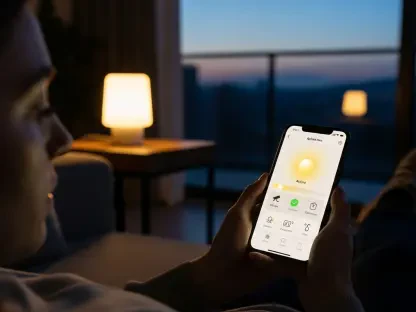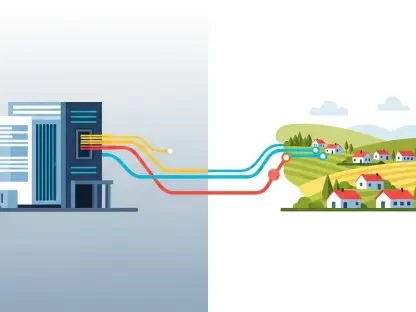Imagine being stranded in a remote canyon with no cell signal, unable to call for help or navigate back to safety, a scenario that poses a real and daunting challenge for millions venturing into isolated areas across the U.S. With traditional networks often failing to reach beyond urban boundaries, the need for reliable communication in such regions has never been more critical. This roundup dives into T-Mobile’s groundbreaking T-Satellite service, powered by Starlink, gathering perspectives from industry analysts, consumer feedback, and competitive comparisons to explore how this innovation is reshaping remote connectivity. The aim is to provide a comprehensive look at the potential, challenges, and future of satellite-based solutions in modern mobile plans.
Exploring T-Mobile’s T-Satellite Innovation
Partnership with Starlink: A Bold Step Forward
T-Mobile’s collaboration with Starlink, leveraging over 650 satellites, has been hailed as a significant advancement in extending connectivity to areas where terrestrial networks are nonexistent. Industry observers note that this partnership enables coverage in some of the most isolated regions, offering a lifeline for emergencies and everyday communication. The technology’s ability to deliver service, provided there is a clear line of sight to the sky, marks a pivotal shift in how mobile networks can operate beyond conventional limits.
Feedback from early adopters highlights the real-world impact of this service, with stories of rescues and enhanced safety in remote locations circulating widely. However, some analysts caution that the requirement for unobstructed sky access poses a limitation, especially in dense forests or narrow valleys. This sparks a debate on whether satellite technology can truly serve as a complete substitute for ground-based infrastructure or if it remains a complementary solution.
Comparisons with other satellite initiatives reveal that while T-Mobile’s rollout has gained traction, there are lingering questions about scalability. Experts suggest that expanding satellite coverage to handle high user volumes without compromising speed or reliability remains a hurdle. This perspective underscores the need for continuous investment in satellite infrastructure to meet growing demand in underserved areas.
App Integration: Enhancing Functionality for Users
One of the standout features of T-Satellite is its support for popular apps like WhatsApp, Google Maps, and AllTrails, which significantly boosts its utility for navigation and communication in off-grid scenarios. Consumer insights emphasize the value of accessing trail data or sending voice notes during outdoor adventures, transforming how individuals stay connected when far from civilization. This integration is seen as a game-changer for hikers, campers, and families on remote trips.
On the flip side, some users point out limitations in app-specific functionalities over satellite connections, such as slower data speeds compared to traditional networks. Analysts also note that while T-Mobile currently leads in app diversity for satellite services, competitors are rapidly catching up, pushing for broader app ecosystems. This competitive pressure could drive further innovation, benefiting consumers with more robust tools for remote access.
A recurring theme in discussions is the balance between functionality and user expectations. While the ability to use essential apps in isolated areas is celebrated, there is a call for clearer communication about performance constraints under satellite conditions. This feedback suggests that educating users on what to expect could enhance satisfaction and adoption rates over time.
Non-Terrestrial Connectivity: An Emerging Standard
The shift toward satellite services as a core component of mobile plans is gaining momentum, with many industry leaders predicting it will become as commonplace as international roaming within the next few years. This trend reflects a growing recognition of connectivity as a fundamental need, regardless of location. T-Mobile’s early adoption of this technology positions it as a frontrunner in redefining wireless service expectations.
Regional variations in adoption highlight disparities in demand, with rural and outdoor-focused communities showing greater enthusiasm compared to urban users. Analysts suggest that targeting these underserved demographics could accelerate the normalization of satellite connectivity. The potential for growth in such markets is seen as a key driver for carriers to invest in non-terrestrial solutions.
Challenging the notion that satellite services are a luxury, many voices in the industry argue they are evolving into a necessity. This perspective is fueled by increasing reliance on digital tools for safety and personal needs, even in remote settings. The consensus points to a future where seamless access, regardless of geography, becomes a baseline standard for mobile providers.
Pricing Strategies and Consumer Adoption Patterns
T-Mobile’s pricing model for T-Satellite, included in premium plans or available as a $10 monthly add-on, is often compared to similar offerings from competitors like Verizon and AT&T, which also hover around the same price point. Industry analysts appreciate the flexibility of activating and canceling the service as needed, aligning with situational usage rather than ongoing subscriptions. This approach is seen as a practical way to cater to users who only require satellite access for specific events like remote travel.
Consumer behavior studies indicate a preference for this pay-as-needed model, particularly among occasional adventurers who value the service for its potential to save lives on a single trip. However, some experts question whether this sporadic usage will sustain long-term engagement or if carriers need to bundle additional incentives to encourage consistent adoption. The debate centers on how to frame the value proposition to a broader audience.
Another angle in this discussion is the perception of cost versus benefit. While the $10 fee is considered reasonable for emergency preparedness, there is skepticism about whether users will prioritize it without experiencing a direct need. This insight suggests that marketing efforts focusing on real-life impact stories could play a crucial role in shaping consumer attitudes toward satellite connectivity.
Key Takeaways from the Satellite Connectivity Debate
Impact and Practical Applications
T-Mobile’s T-Satellite initiative stands out for its role in tackling the persistent challenge of remote connectivity, with app integration adding significant practical value for users in isolated areas. Feedback from various stakeholders underscores the service’s effectiveness in emergencies and recreational settings, painting a picture of tangible benefits. This broad support highlights the potential for satellite solutions to redefine how mobile networks address coverage gaps.
For users, a practical tip is to consider opting for satellite add-ons during planned trips to remote locations, ensuring access to critical tools when traditional signals fail. Carriers, on the other hand, are encouraged to prioritize expanding app diversity and improving user education on satellite limitations. These strategies could enhance the overall experience and drive wider acceptance of such services.
An additional piece of advice for consumers is to check plan compatibility and manage usage through dedicated apps like T-Life for a seamless activation process. Planning around specific needs, such as a weekend hike, can maximize the value derived from the service. This tailored approach ensures that the technology serves its purpose without unnecessary costs.
Competitive Landscape and Industry Trends
The broader industry movement toward ubiquitous connectivity is evident as competitors like Verizon and AT&T ramp up their satellite offerings, signaling a race to dominate this emerging space. Differing approaches to partnerships and service features create a dynamic environment where innovation is spurred by rivalry. T-Mobile’s current lead in app integration is noted, though the gap with others is narrowing rapidly.
Analysts stress that the lasting importance of closing connectivity disparities lies in ensuring access for all, particularly in underserved regions. The ongoing evolution of satellite technology is expected to bring more comprehensive coverage and enhanced capabilities over time. This trajectory points to a future where remote access is no longer a barrier but a given in mobile plans.
A critical observation from industry discussions is the need for collaboration between carriers and satellite providers to address technical challenges like latency and capacity. Such partnerships could unlock new possibilities for seamless integration into everyday use. This cooperative spirit is seen as essential for sustaining the momentum of non-terrestrial connectivity advancements.
Reflecting on the Path Traveled
Looking back, the exploration of T-Mobile’s T-Satellite service through diverse perspectives revealed a transformative step in bridging remote connectivity gaps. The roundup of opinions from industry analysts, user experiences, and competitive insights painted a vivid picture of an evolving landscape. For those intrigued by this development, delving into carrier-specific resources or tech blogs for the latest updates on satellite services was a common recommendation. Users were advised to evaluate their connectivity needs and explore flexible plan options to stay prepared for remote scenarios. Engaging with community forums to share and learn from real-world applications of such technology also emerged as a valuable next step to deepen understanding and adoption.









